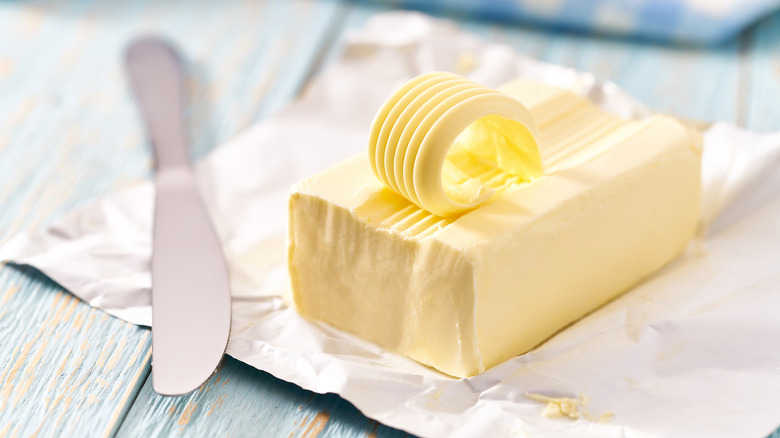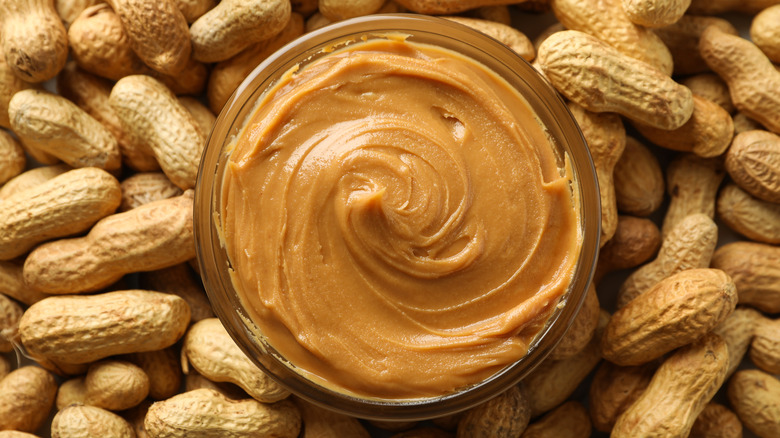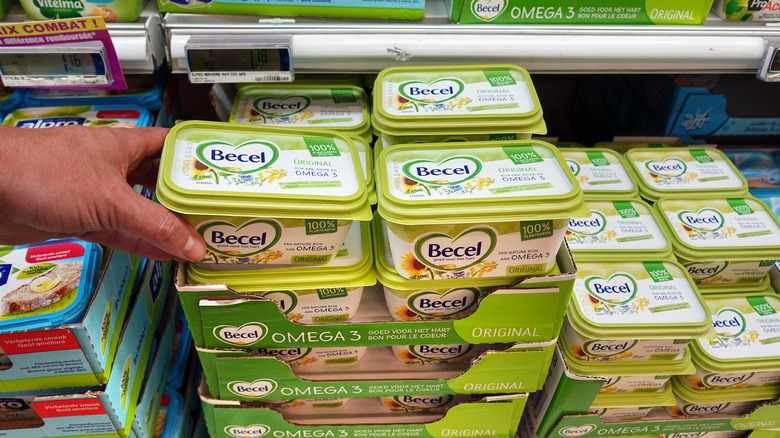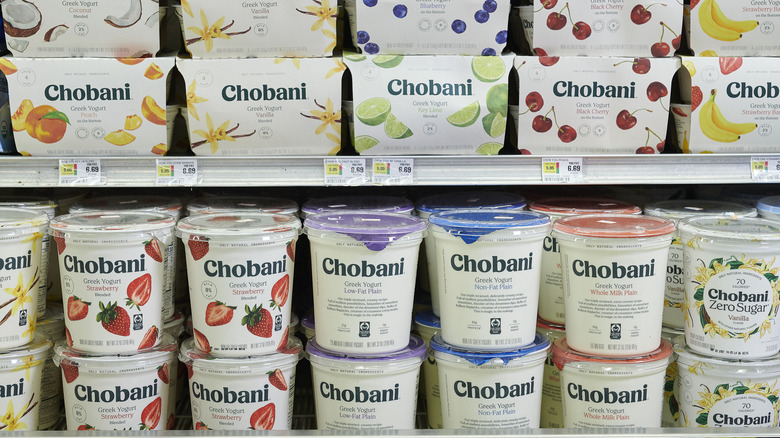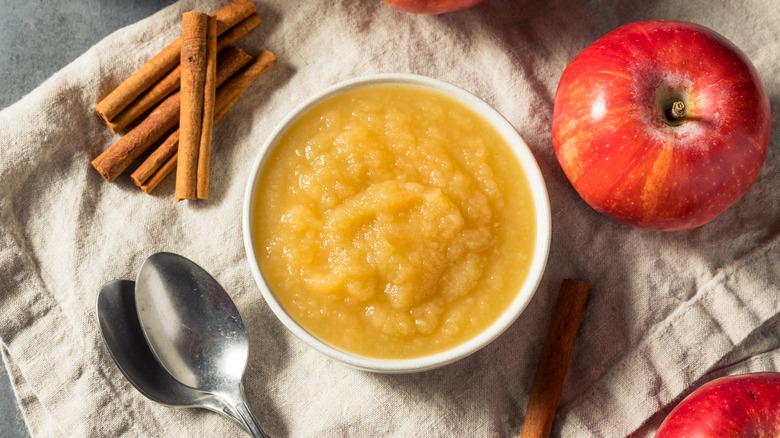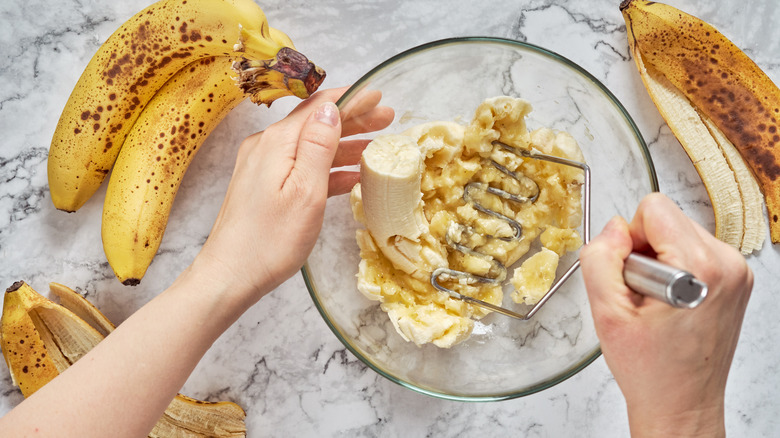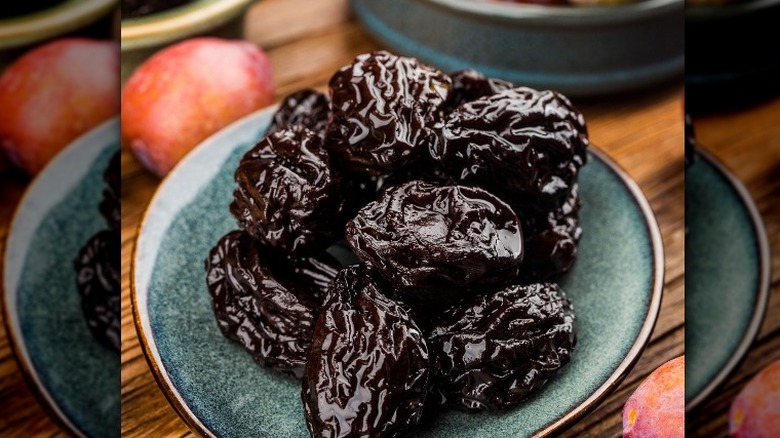The Absolute Best Butter Substitutes
We all know butter. It's one of the most basic ingredients that's used in an array of recipes, like with a slice of cinnamon toast or melted over some delicious popcorn — butter is everywhere. So what are you supposed to do if you run out of this staple substance? Sure, you could make your own. You just churn some cream until solids form and you have butter, says the Dairy Council of Northern Ireland (okay, it sounds easy, but as anyone who's ever tried it knows, it's pretty time-consuming and laborious). And what if you're vegan or have dietary restrictions and are looking for a dairy-free substitute? Is there anything that you can swap out while still sticking to your dairy-free lifestyle?
Substituting butter in a recipe all comes down to what the butter is doing for the dish in question. In some cases, butter just adds the necessary fats. In others, it provides flavor, and in some, it provides texture. To help you find the best butter substitute for your needs, here are the absolute best butter substitutes, how to use them, and when to use them.
1. Oil
Since butter is a fat, it just makes sense that you can swap it out for another fat in many recipes. Note that this is just the case in some recipes, not all. You can swap out butter for a variety of oils, including olive, canola, vegetable, or coconut oils. In general, use oil to replace your butter if the recipe requires the butter just for the fat content.
If your recipe asks you to melt a pat of butter in a pan before pan-frying something, for example, you can easily swap out the butter for oil, and you won't notice a difference. However, if the recipe is using butter for its texture — such as in baking or a sauce or frosting — this swap won't work for you. If you are switching out your butter for olive, canola, vegetable oil, or most other oils, you can add the oil in a 1-to-1 ratio to the amount of butter called for, says Go Dairy Free.
2. Peanut butter and oil
Did you hope that you'd be able to easily swap out the butter in your baked goods for that oil already in your pantry? While using oil in place of butter isn't always a great option for baking vegan or dairy-free items, you can have greater success when using a combination of oil and peanut butter. As Leaf explains, this combination can render a lighter, less dense texture than what you might get if using oil alone in place of butter.
This combination is particularly ideal if your recipe asks you to cream butter with sugar because it helps create air pockets to leaven your baked item. Do note, though, that the peanut butter will slightly change the end taste, but if you already love peanut butter, you won't mind. Combine peanut butter and oil in equal parts, and then replace your recipe's butter with this mixture at a 1-to-1 ratio.
3. Margarine
Margarine is an easy swap for butter, right? After all, isn't it basically the same thing? Well, not entirely. While margarine is a nice dairy-free, vegan substitute in many instances, it doesn't always behave the same as butter. That makes it a useful substitute sometimes, but not in every recipe. If you're making a baked item that heavily relies on texture (like pastry dough, for example), you might find the results of baking with margarine lackluster.
As Southern Living reports, baking with margarine results in doughs that are softer and less crispy, and they don't brown as well as butter-made baked goods. Additionally, if your recipe relies on butter for taste, you might find margarine's flavor a little bland. However, if you're baking something that's intended to be moist and dense (like pound cake), or if your recipe uses butter for its fat content only, you'll be safe to use margarine with no ill effects. Substitute margarine for butter at a 1-to-1 ratio, Farm Flavor reports.
4. Vegan butter
Much like margarine, vegans or others following a non-dairy lifestyle may be quick to reach for the vegan butter, but, again, it's not the same as real butter. Often made from a variety of plant-based oils, vegan butter doesn't offer the same classic butter taste. However, the special combination of oils — which can range from flax to soybean, palm, coconut, sunflower, and more — is usually enough to help you produce your baked goods.
Vegan butter is best in recipes like flaky and tender pie crusts and pastry doughs, as well as denser baked items like biscuits — which the pros at The King Arthur Baking Company discovered in a side-by-side baking comparison against traditional butter. So, vegan butter may very well become your go-to pick for butter-free baking, even if you're not vegan. However, you might want to skip the vegan butter if you're cooking something that relies on butter for taste, such as buttercream frosting or buttered pasta. You can swap out vegan butter for regular butter in equal parts.
5. Shortening
Another fat that's easy to assume is a quick swap for butter is shortening. But, just like margarine and vegan butter, it isn't the same thing as butter, meaning it's a good swap some of the time, but not all the time. Shortening is made from 100% hydrogenated vegetable oil (via Land O'Lakes) and often goes by the brand name Crisco. Shortening has little to no taste, so it's not a good pick for recipes that rely on butter for its flavor. Despite that, it's actually superior to butter in some baking projects, according to The Forked Spoon.
Shortening is known to make some baked goods lighter and airier, allowing them to rise higher than they might have if made with regular butter. Shortening also has a high smoke point, making it better than butter for frying. Shortening is likewise shelf-stable and more affordable than butter. So, if you're frying something, or baking something particularly light and fluffy, feel free to reach for the shortening — even if you're not out of butter! You can use shortening in recipes calling for butter in an equal amount.
6. Greek yogurt
Let's say you're not worried about the dairy content, and you just need a quick swap for that butter you forgot to pick up at the grocery store. If you have some Greek yogurt on hand, you might be able to use that instead. As Our Everyday Life explains, this is a popular pick for those who want to cut down on fat content in their baked goods without sacrificing texture.
Do note, though, that you'll get a bit of that characteristic Greek yogurt flavor in whatever you're making if you use it instead of butter. While this is fine in some cases (such as in recipes that already use slightly tangy ingredients, like buttermilk), it might not be desirable in others. Additionally, you don't want to use flavored Greek yogurt as a butter replacement. Instead, use plain, non-fat Greek yogurt. You can use Greek yogurt as a butter substitute in equal amounts.
7. Mayonnaise
Another good butter substitute option if you're not going vegan is mayonnaise. It is made from eggs, oil, vinegar, and lemon, so it offers the fat content and creaminess that you might desire from butter. However, mayonnaise isn't always going to be a great pick as a butter substitute, depending on what you're making. Sweet baked goods aren't always going to benefit from mayo's tang.
Yes, there are baking recipes that call for mayonnaise, but it's not typically there as a butter substitute; the mayonnaise is included to provide a very specific flavor and texture. Instead, you might find that mayonnaise works as an awesome butter substitute when making things like grilled cheese sandwiches (or any other recipe that requires you to toast some bread), scrambled eggs, corn on the cob, or mashed potatoes. For recipes like these, where — let's face it — you're more likely to eyeball your butter amount than measure it, feel free to do the same with your mayo.
8. Cream cheese
Similar to Greek yogurt, cream cheese is another item that you'll find in the dairy aisle that can be used in place of butter in a pinch. While cream cheese does contain less fat than butter, it can be effectively used as a replacement in cream-based sauces or in dishes that require melted butter for its creamy texture, like mashed potatoes. Unfortunately, cream cheese is not a good pick for baking projects, as cream cheese can thoroughly throw off the texture.
According to Our Everyday Life, you will want to soften or melt your cream cheese before using it. After softening, you can measure it in equal quantities to whatever your recipe calls for for the melted butter. To melt the cream cheese, add one half of a cup of cream cheese to one cup of milk or broth in a saucepan and stir until you get your desired consistency. To soften the cream cheese for use in sauces that do not require fully melted butter, you can microwave the cream cheese for 15 seconds.
9. Corn starch and oil
If you're specifically looking for a butter replacement for a sauce recipe, a combination of corn starch and oil may just do the trick. Typically, butter is added to sauces to create a velvety, rich consistency. The butter also, of course, adds some extra flavor. If you're out of butter, though, you can use a mixture of cornstarch and olive oil. The olive oil provides some flavor and fat, while the corn starch offers emulsifying properties that give your sauce the desired texture.
Plus, when you use corn starch and oil in place of butter, there's no need to make a corn starch slurry like you might normally do for other recipes. For this substitution, add ½ teaspoon of cornstarch plus olive oil in an equal amount to your called-for butter to your sauce. This will result in enough sauce for two servings of pasta. If your sauce recipe is intended for more than two servings, you'll need to do a little bit of math.
10. Applesauce
But let's forget all the cream cheese, Crisco, and mayonnaise for a moment. What if you specifically want a butter substitution that's vegan? Luckily, there are a few vegetable and fruit-derived substitutions that can act as stand-ins. Applesauce, according to The Nest, works as a butter replacement in certain baked goods, including breads, muffins, and some cakes (and even better in apple-based items, obviously). The resulting texture will be slightly softer, though, which means applesauce is not a good substitution for items that normally have a crispy or crunchy texture (like most cookies).
You can use applesauce as a butter substitute at a 1-to-1 ratio. However, The Nest recommends starting slow the first time you use applesauce as a substitution, just to test how your particular recipe reacts to the swap: They suggest using ½ cup of your chosen oil and ½ cup of applesauce for every 1 cup of butter needed.
11. Bananas
Are apples not your preference? Then reach for some bananas the next time you need some butter, instead. Bananas are a suitable swap for butter if you're looking to vegan-ize your favorite baking recipe or if you just want to cut down on the calories and fat that butter adds to your favorite baked items. While bananas won't provide the exact same texture that butter will, they can provide moisture and sweetness, so they are a better fit for breads, muffins, and other densely baked items, says Live Strong. Light, flaky, or crunchy baked goods are not a good fit for this substitution (think batter-based baked goods versus dough-based baked goods).
Live Strong recommends adding half as much mashed banana to your batter as the called-for butter. If your batter seems too dry after that, you can add a little more. Additionally, the outlet notes that if you swap bananas out for butter in a recipe, you can use less sugar and half the amount of eggs as your recipe calls for, and you'll also want to reduce the baking temperature by 25 degrees Fahrenheit.
12. Avocado
This fatty fruit can add needed fat to your baked goods while also acting as a stand-in for butter in vegan recipes. Of course, you will need a ripe, mashable avocado for this swap, as AZ Central explains, and you'll need to mash your avocado before you add it to any recipe. However, using avocado as a butter substitute can alter both the flavor and color of your resulting baked item. To avoid this, use it as a substitute in recipes that include other, more dominant flavors and colors, such as chocolate cake or brownies.
The Kitchn also cautions that since avocado won't add as much moisture to your recipe as butter will, you'll need to slightly increase your recipe's wet ingredients. You may also want to lower your oven temperature by 25 degrees Fahrenheit to avoid over-cooking. Use a 1-to-1 ratio when replacing avocado for butter in any recipe.
13. Canned beans
Do you have a can of beans in your pantry? They'll make for a good butter substitute in a pinch. As One Good Thing explains, you can use a variety of beans for your butter substitute. Great Northern beans are ideal if you're worried about a bean-like color or flavor. If you're baking something darker or with a stronger flavor, like a spice cake or chocolate cake, you can go with something like pinto or black beans, as the colors and flavors won't be as obvious.
Be sure to drain the beans before adding them to your recipe and, for best results, mash or puree the beans as well. Using beans in place of butter will result in more of a cakey texture than chewy, and you won't notice as much browning (via Cooking Dairy Free). Benefits include additional protein in your diet and an easy vegan swap. Substitute the beans for the butter in your recipe at a 1-to-1 ratio.
14. Pumpkin puree
If you still have a leftover can of pumpkin from the holiday season languishing away in the back of your pantry, you can use that pumpkin puree in your next baking project in place of butter. According to the Herald-Standard, you can also use pumpkin puree as a substitute for eggs. So, if you're making a simple boxed baking mix, for example, that just requires you to throw the mix, eggs, oil or butter, and water into a bowl, you can simply blend the cake mix with your pumpkin puree and pop it in the oven.
However, while pumpkin puree can replace the moisture and fat that butter provides, it's not great at leavening, so if you're making something that requires you to cream butter and sugar together, in order to create those needed air pockets, you may not want to use this particular swap. According to PopSugar, multiply the amount of butter called for in your recipe by ¾ to determine how much pumpkin puree you'll need.
15. Prune puree and oil
While you may have heard of adding mashed avocado or applesauce to your baked goods for their health benefits (even if not directly as a butter substitute), you've likely never heard of this unique butter swap — prune puree. This distinct fruit adds sugar, moisture, and loft to lots of baked goods while, as California Prunes describes, eliminating refined sugar, fat, and dairy. Do note, though, that prune puree is the best butter replacement for simpler recipes like one-bowl cakes, bread, muffins, and other items that do not require you to beat butter and sugar together, as well as items that don't require you to make a dough.
Additionally, prunes are dark in hue and attention-grabbing in flavor; if you don't want that purple color or that flavor, consider adding prune puree only to darker, richly-flavored baked items, like those including chocolate. To replace the butter in your recipe, use a mixture of equal parts prune puree and oil, which, in combination, equal the total amount of butter needed.
